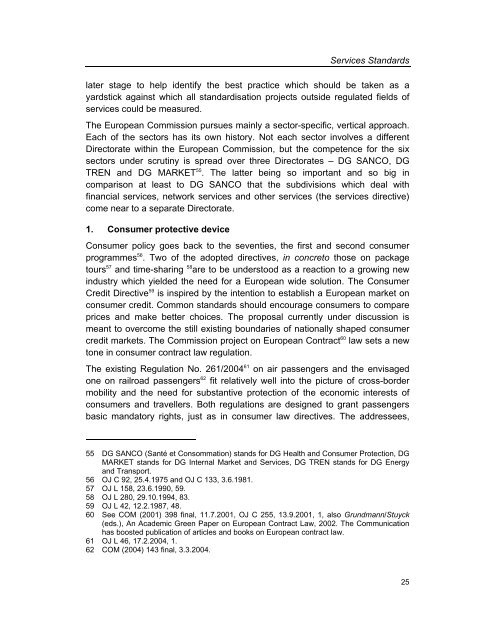Services Standards: Defining the Core Consumer Elements ... - ANEC
Services Standards: Defining the Core Consumer Elements ... - ANEC
Services Standards: Defining the Core Consumer Elements ... - ANEC
Create successful ePaper yourself
Turn your PDF publications into a flip-book with our unique Google optimized e-Paper software.
<strong>Services</strong> <strong>Standards</strong><br />
later stage to help identify <strong>the</strong> best practice which should be taken as a<br />
yardstick against which all standardisation projects outside regulated fields of<br />
services could be measured.<br />
The European Commission pursues mainly a sector-specific, vertical approach.<br />
Each of <strong>the</strong> sectors has its own history. Not each sector involves a different<br />
Directorate within <strong>the</strong> European Commission, but <strong>the</strong> competence for <strong>the</strong> six<br />
sectors under scrutiny is spread over three Directorates – DG SANCO, DG<br />
TREN and DG MARKET 55 . The latter being so important and so big in<br />
comparison at least to DG SANCO that <strong>the</strong> subdivisions which deal with<br />
financial services, network services and o<strong>the</strong>r services (<strong>the</strong> services directive)<br />
come near to a separate Directorate.<br />
1. <strong>Consumer</strong> protective device<br />
<strong>Consumer</strong> policy goes back to <strong>the</strong> seventies, <strong>the</strong> first and second consumer<br />
programmes 56 . Two of <strong>the</strong> adopted directives, in concreto those on package<br />
tours 57 and time-sharing 58 are to be understood as a reaction to a growing new<br />
industry which yielded <strong>the</strong> need for a European wide solution. The <strong>Consumer</strong><br />
Credit Directive 59 is inspired by <strong>the</strong> intention to establish a European market on<br />
consumer credit. Common standards should encourage consumers to compare<br />
prices and make better choices. The proposal currently under discussion is<br />
meant to overcome <strong>the</strong> still existing boundaries of nationally shaped consumer<br />
credit markets. The Commission project on European Contract 60 law sets a new<br />
tone in consumer contract law regulation.<br />
The existing Regulation No. 261/2004 61 on air passengers and <strong>the</strong> envisaged<br />
one on railroad passengers 62 fit relatively well into <strong>the</strong> picture of cross-border<br />
mobility and <strong>the</strong> need for substantive protection of <strong>the</strong> economic interests of<br />
consumers and travellers. Both regulations are designed to grant passengers<br />
basic mandatory rights, just as in consumer law directives. The addressees,<br />
55 DG SANCO (Santé et Consommation) stands for DG Health and <strong>Consumer</strong> Protection, DG<br />
MARKET stands for DG Internal Market and <strong>Services</strong>, DG TREN stands for DG Energy<br />
and Transport.<br />
56 OJ C 92, 25.4.1975 and OJ C 133, 3.6.1981.<br />
57 OJ L 158, 23.6.1990, 59.<br />
58 OJ L 280, 29.10.1994, 83.<br />
59 OJ L 42, 12.2.1987, 48.<br />
60 See COM (2001) 398 final, 11.7.2001, OJ C 255, 13.9.2001, 1, also Grundmann/Stuyck<br />
(eds.), An Academic Green Paper on European Contract Law, 2002. The Communication<br />
has boosted publication of articles and books on European contract law.<br />
61 OJ L 46, 17.2.2004, 1.<br />
62 COM (2004) 143 final, 3.3.2004.<br />
25
















